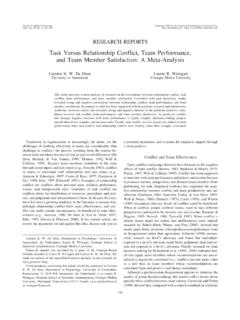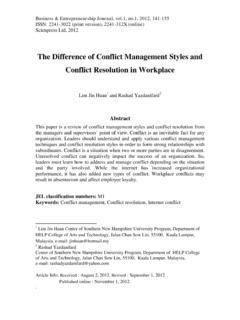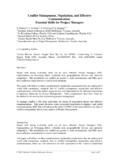Transcription of Report of the Task Force on Building Names and ...
1 Report of the Task Force on Building Names and Institutional History February 25, 2019 This version includes proofreading corrections, copyediting clarifications, stylistic and formatting adjustments. 2 Executive Summary of the Report Our Report begins with a recap of the establishment of the Task Force on Building Names and Institutional History, the charge and work of the Task Force , and the foundation of that work in core University values and the principles for naming and renaming significant University assets recommended by last year s President s and Provost s Advisory Committee on University History (the Coleman Committee ). We review public input to the Task Force and then present the four cases we were charged with considering. In examining these cases, we provide a review of the individual s career, including accomplishments as well as actions that have drawn sharp criticism.
2 As called for by the Coleman Committee, after reviewing their careers we provide a set of arguments for and against removing the name from each Building . We conclude each case analysis by applying the principles of change, diversity, preservation, exceptionality, and deliberation, as recommended by the Coleman Committee, to determine whether removing a name from a Building is warranted. Our Report concludes with a discussion of initiatives beyond naming that might be taken up by the permanent Advisory Committee to the President on University History that will begin its work this semester. President Eric Kaler and Executive Vice President and Provost Karen Hanson charged Task Force members on October 4, 2018, calling on the Task Force to recommend actions regarding the specific buildings mentioned in A Campus Divided (Coffman Memorial Union, Coffey Hall, Middlebrook Hall, and Nicholson Hall) and the Minnesota Student Association proposal to rename Coffman Memorial Union and to utilize tools to gather community feedback on the buildings in question.
3 Under Section VII of the Board of Regents naming policy, the decision whether to remove a name from a Building or other significant University asset lies with the Board of Regents. The policy states that for all namings requiring Board approval, the Board reserves the right to revoke them. Other namings may be revoked by the president or delegate. The advisory recommendations of the Task Force will be considered by President Kaler and Provost Hanson, following which President Kaler will present recommendations to the Board on the four buildings in question. The Board of Regents Policy on Namings, Section II, states that it is critically important that the integrity, history, behavior, and reputation of the named individual or organization be consistent with the academic mission and values of the University. This formulation sets actions and adherence to institutional values to be of the highest importance in the naming process.
4 As we employ and apply core University values and the Coleman Committee s guiding principles in our analysis, we do not seek to impose arbitrarily on individuals of the past our expectations from today. Although it is reasonable for today s values to guide what we wish to honor with the distinction of a naming, we also believe and understand that individuals need to be assessed within the context of their own time and what was then imaginable and possible. We endeavor to measure their actions against the norms and practices of their day but also consider whether the values they stood for are in conflict with those of our own time. History teaches the perils of uncritical condemnations as well as commendations, reinforcing the importance of exercising empathy and humility in examining the words and deeds of generations past, asking ourselves what values we would have held had we lived then, and remaining mindful of how the future might regard our values.
5 Coffman Memorial Union was completed in 1939 and posthumously named for Lotus Delta Coffman, pr esident of the University from 1920 to 1938. The Building is located on the East Bank campus of the University of Minnesota Twin Cities. President Coffman is remembered most frequently for his expansion of the University, both in its physical facilities and in its outreach to broader student populations through 3 educational innovations like the General College. Coffman also saw throughout his term increasing demands for equity and inclusion of student populations who were subject to various forms of discrimination. Rather than working to redress these inequities and promote integration, however, Coffman used his authority to exclude African American students from University facilities, most evidently in housing, some medical training programs, and athletics. President Coffman sometimes claimed to be acting in the best interests of the students excluded from facilities, programs, and activities and denied that the University had a policy of exclusion, but archived correspondence shows that Coffman and other members of his administration regarded exclusion as the presumptive norm, particularly with respect to student housing.
6 Our Report provides details of his actions in historical context and concludes with a recommendation to remove his name from the student union. Completed in 1890, Nicholson Hall is located on the East Bank campus of the University of Minnesota Twin Cities. The Building once served as the student union and now serves as the home to academic departments, centers, and programs. In 1945, the Building was named for Edward E. Nicholson, who served as the University s first dean of student affairs from 1917 until his retirement in 1941. Nicholson was a complex and controversial figure. Affectionately called Dean Nick, he was seen by some as a benevolent leader who cared deeply for students. Examination of archival material, however, reveals a man who also abused his official powers. Nicholson censored political speech on campus and conducted surveillance on student activists in coordination with former State Auditor (1921 31) and former Representative (Republican, at large, 1933 35) Ray P.
7 Chase. Nicholson exhibited antisemitism and racism in his actions as a University administrator, often targeting Jewish and Black students whom he labeled communists. Our Report on Nicholson concludes with a recommendation to remove his name from the Building now known as Nicholson Hall. Middlebrook Hall is an undergraduate residence hall on the West Bank campus of the University of Minnesota Twin Cities. The Building also housed graduate students when it opened. Before its construction, it was named for William T. Middlebrook in 1966. William T. Middlebrook had a long career in the upper echelons of University central administration, serving as comptroller from 1925 to 1943 and as vice president for business administration from 1943 until his retirement in 1959. Middlebrook s accomplishments were many. He dedicated much of his career and his administrative acumen to Building and managing the physical structure of the University, including student housing, in order to increase its capacity to provide educational opportunities to citizens in Minnesota.
8 In his official capacity, however, research reveals that he worked on behalf of the University to support policies and practices that discriminated against students of color and Jewish students with respect to access to housing. In decades when the University faced recurrent calls for equity in the provision of campus housing for all racial and ethnic groups and integration of these spaces, Middlebrook did not use his considerable power and discretion to assist in the provision of such facilities. Instead, his work enabled and perpetuated discrimination. In light of this research, our Report recommends the removal of his name from the undergraduate residence hall. Built in 1907 and named for Walter Castella Coffey in 1949, Coffey Hall is located on the St. Paul campus of the University of Minnesota Twin Cities. After serving as dean of the Department of Agriculture (1921 41), Walter Castella Coffey served as president of the University (1941 45).
9 Coffey was viewed as a student-oriented leader who extended the reach of the Department of Agriculture across the state and stewarded the University through the war. Coffey s wartime administration also coincided with a critical period of social 4 struggles for civil rights and equal access at the University. Rather than working to realize the democratic vision of the University that students fought for during the 1930s and which President Guy Stanton Ford officially adopted in 1937, President Coffey and his administration reversed course. Our research reveals the role President Coffey played in establishing segregated housing in 1942. President Coffey and his administration supported policies that attempted to exclude and segregate Blacks, ensuring that the University he presided over was a less equitable institution than the one he inherited from President Ford. Our Report recommends the removal of his name from the St.
10 Paul campus administrative Building . Our recommendations to remove the Names from these buildings do not deny that these individuals operated within structures and systems that imposed constraints on what they saw as possible ways of carrying out their official duties. But neither do we believe they were without choice, particularly given the power and discretion they exercised in their administrative roles. Other choices were often being made at other institutions, and significant levels of community and campus activism, protesting University policies and practices at the time, showed that other ways of thinking were powerfully present. And other University administrators, such as President Guy Stanton Ford, did make different decisions. For all four of these buildings, whether the name is removed or not, we recommend the installation of a permanent exhibit that explores the legacy of the named individuals, including their positive accomplishments and the research detailed in this Report .







